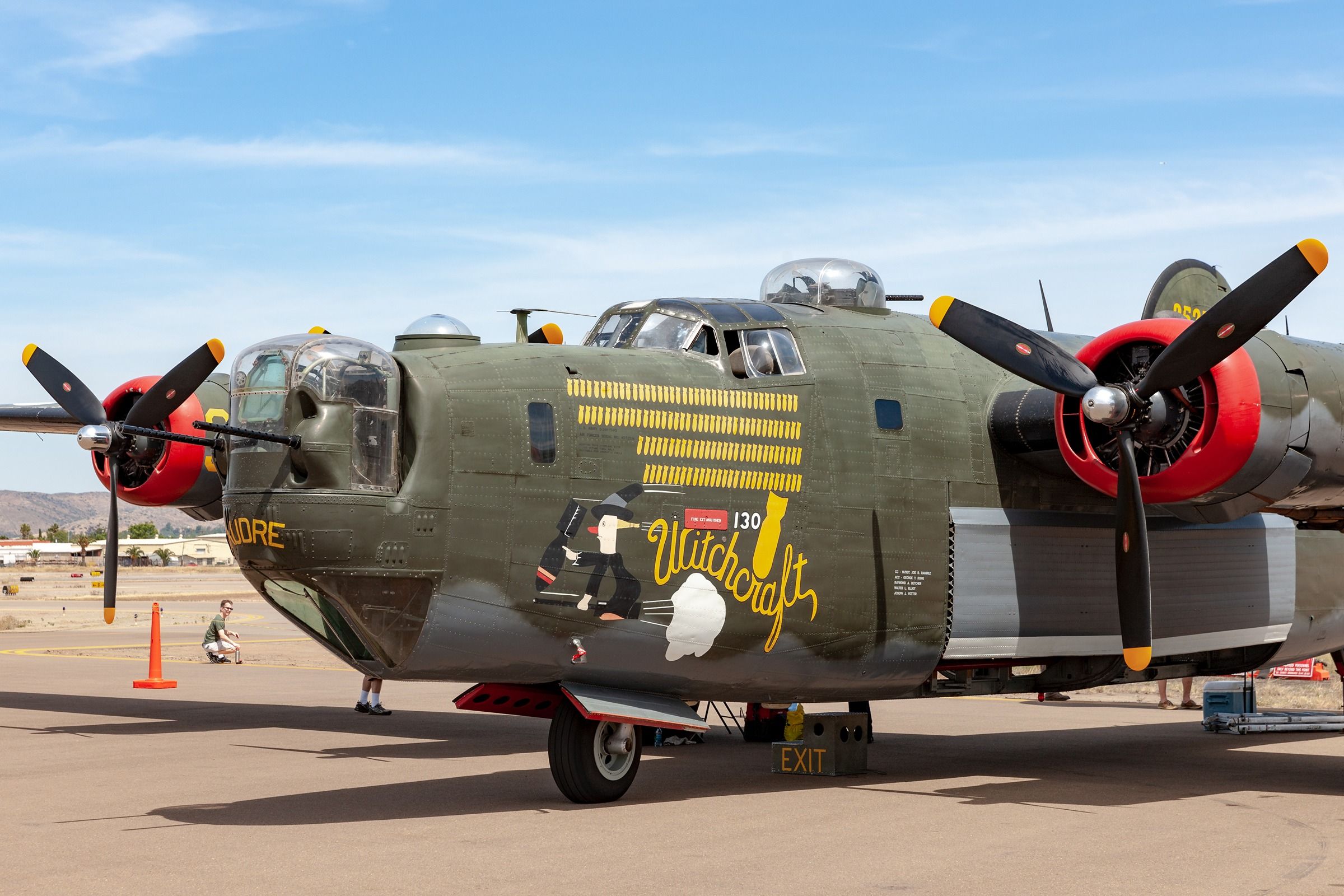Summary
- The B-24 Liberator is the most produced heavy bomber, used by US Forces and Allied Powers in various roles.
- The plane had operational flaws, such as a solitary exit door, a fuel system prone to leaks, and poor low-speed performance.
- The B-24 had a lower service ceiling than its competitors, making it more vulnerable to damage and downing.
World War II-era military planes were some of the most advanced and efficient combat machines. Whether a pure fighter and interceptor or a heavy bomber, thousands of planes of each type were produced. The Consolidated B-24 Liberator is one such aircraft, the most produced heavy bomber. Designed and developed by US-based Consolidated Aircraft, the aircraft performed its first flight in December 1939 and entered United States military service in 1941. More than 18,000 examples of the B-24 Liberator were produced between 1940 and 1945. At least two out of a handful of surviving B-24s are still airworthy.
The B-24 Liberator
- Crew: 11 (pilot, co-pilot, navigator, bombardier, radio operator, nose turret, top turret, 2 waist gunners, ball turret, tail gunner)
- Length: 67 ft 2 in (20.47 m)
- Wingspan: 110 ft (34 m)
- Height: 17 ft 7.5 in (5.372 m)
- Max takeoff weight: 65,000 lb (29,484 kg) plus
- Fuel capacity: 2,344 US gal (1,952 imp gal; 8,870 L) normal capacity; 3,614 US gal (3,009 imp gal; 13,680 L) with long-range tanks in the bomb bay; Oil capacity 131.6 US gal (109.6 imp gal; 498 L) in four self-sealing nacelle hopper tanks
- Powerplant: 4 × Pratt & Whitney R-1830-35 Twin Wasp, R-1830-41 or R-1830-65 14-cylinder two-row air-cooled turbo-supercharged radial piston engines
- Power per engine: 1,200 horsepower (890 kW)
Work began on the B-24 Liberator design in the late 1930s. The aircraft was used in every division of the US Armed Forces, including the Navy. A number of Allied Forces also operated the aircraft during the Second World War. The B-24 is known for its roles and achievements within the US Forces. It participated in the first attack on German soil during the war.

Related
5 Fast Facts About The Consolidated B-24 Liberator Heavy Bomber
The most-produced American military aircraft in history wasn’t devoid of flaws in design.
The B-24’s operational and combat range proved useful for operators, particularly for bombing operations in the Pacific. During the Battle of the Atlantic, the long-range anti-submarine B-24s proved to be instrumental in covering the Mid-Atlantic gap. The rapid production of the aircraft greatly facilitated the missions during World War II. According to the United States Air Force (USAF),
“The B-24 “Liberator” was produced in greater numbers than any other aircraft during the war. It was used primarily in the Far East against Japan and also saw action in Europe and North Africa. The twin-tail, four engine aircraft is best known for its bombing raids on the Ploesti oil fields in August 1943.”
The Flying Coffin
Some design and operational flaws
- Solitary exit door towards the rear of the aircraft
- Susceptibility of being downed
- Wings are more prone to wear and damage
- Poor low-speed performance compared to the competitors.
- Leak and flow issues in the fuel system

The aircraft obtained the title “The Flying Coffin” from the crew who flew it due to its inherent design and system flaws. One of the major design flaws was the aircraft’s solitary entry point towards the rear. In an emergency, the crew generally has only seconds to exit the aircraft, and it is nearly impossible to access the exit far away from where most of the crew is stationed.
- Maximum speed: 297 mph (478 km/h, 258 kn) at 25,000 ft (7,600 m)
- Cruise speed: 215 mph (346 km/h, 187 kn)
- Stall speed: 95 mph (153 km/h, 83 kn)
- Range: 1,540 mi (2,480 km, 1,340 NM) at 237 mph (206 kn; 381 km/h) and 25,000 ft (7,600 m) with normal fuel and maximum internal bomb load
- Ferry range: 3,700 mi (6,000 km, 3,200 NM)
- Service ceiling: 28,000 ft (8,500 m)
- Rate of climb: 1,025 ft/min (5.21 m/s)
- Time to altitude: 20,000 ft (6,100 m) in 25 minutes

Related
Battle Of The Bombers: The B-24 Liberator Vs The B-17 Flying Fortress
Two of the most notable aircraft in the World War II era.
The relatively lower service ceiling added to the frequent demise of the B-24s. The aircraft has a ceiling of 28,000 ft (8,500 m), making it a little too susceptible to downing. According to the Encyclopedia Britannica,
“As a result, the B-24 was more exposed to German antiaircraft artillery; this and the B-24’s greater vulnerability to battle damage (the leaky fuel system was a particular problem) made the B-17 the preferred strategic bomber in the European theatre.”
Notably, the B-24 Liberator was hastily designed due to the requirements of a heavy bomber on the US side. While the design went through a comprehensive testing phase, many quick fixes were performed to release the type for certification and subsequent service entry.

Related
Are There Any B-24 Liberators Still Flying Today?
The aircraft took to the skies after a break of over 20 years.
What are your thoughts on B-24 Liberator, the most produced heavy bomber? Have you seen the aircraft in any of the museums recently? Share your experience in the comments section.



